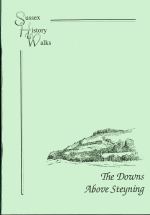
Based on
The Downs Above Steyning
by Graham Kean and Tony Ketteman
A 32 page booklet with a route map and history notes for walkers. Learn more about the ancient downland landscape, including Cissbury’s flint mines, Chanctonbury’s Roman temple, Bronze Age settlers and an ancient burial ground.
Available at Steyning Museum: Price £2.50
Steyning nestles in a valley overlooked by the South Downs. This is an ancient landscape, criss-crossed by tracks first used by Neolithic hunters, farmers and traders six thousand years ago. The South Downs Way traces some of these tracks in a route along the South Downs chalk ridge from Winchester to Eastbourne. It passes Upper Beeding, Bramber and Steyning, although archaeology shows that these riverside settlements are recent in comparison to the cultures which created the chalk downland environment above.
The South Downs was once an area of dense forest. It was transformed by a new way of life which spread from the region of Iran, Iraq and Turkey. Roaming hunter-gatherers were either marginalised or absorbed into pioneering new settlements, complete with farm animals and cultivated crops. The light soil of the chalk hills was gradually cleared of trees for grazing and planting. Farmers were better able to survive seasonal shortage and to provide for growing numbers. They even produced surplus goods for wide-ranging trade and spared a huge amount of labour to build communal monuments.
There is evidence of the earliest local trade on Cissbury Ring. Over 270 flint mine shafts are still visible as shallow depressions. Archaeologists removed the chalk rubble which fills the shafts and revealed skeletons, tools, images scratched into chalk and many clues as to how the mining was done. The Cissbury flint mines produced one of the most important raw materials for Neolithic life. Cissbury flint tools have been found as far away as the Eastern Mediterranean.
Neolothic causewayed enclosures and long barrows have been found several miles to the east and west of Cissbury. These are typical Neolithic structures and evidence of a substantial community. As yet, none have been discovered in the area surrounding Steyning. There are no traces of Neolithic housing or settlements either, but these are scarce throughout Sussex. For the time being, isolated finds of flint tools are the best clues we have that Neolithic people lived around Steyning.
By the early Bronze Age, about 2000 BC, many cultural changes had taken place. Archaeologists find distinctive, decorated pots and describe the life style as Beaker culture. There is evidence of metal working including gold, copper and bronze. The Cissbury flint mines were abandoned. At Steyning Round Hill burial urns and round barrows have been found. These are another sign of culture change, although the long barrows of Neolithic times seem to have served a similar purpose. They were placed at prominent points in the landscape, usually but not always to cover burials, and would have taken enormous community effort to construct. In a broad area surrounding Hove, near Brighton, archaeologists have found particularly valuable burial goods. This suggests that wealthy or high status individuals dominated local life, but whether as hereditary chieftains, priests or warlords is unclear.
Farming and settlement across the South Downs gradually increased. By the later Bronze Age, the boundaries of individual or family land ownership were clearly established. As the number of farmsteads increased, with their wealth of crafts, produce and trade, fewer communal monuments were built. At Park Brow traces of eight circular huts were found in the 1920s. They would have had low wattle and daub walls and a conical thatched roof suported by a central pole. Fortunately, evidence about the people of Park Brow was recorded before deep ploughing by modern farmers stripped the site of its archaeology.
So-called hill forts at Chanctonbury Ring and Cissbury Ring have been interpreted as signs that more dangerous times called for military defences on a regional scale. The ditches and earth banks surrounding the hilltop enclosures seem to have an obvious defensive purpose, but archaeologists have found no evidence that the people who built them ever lived in these places. Perhaps they were only intended to provide refuge and defence for the surrounding community at times of direct attack. To add to the confusion, a Roman temple has been found at Chanctonbury, in the middle of the enclosure. Was it originally a religious site? An excavation during 1988-91 gave the end of the Bronze Age as the period of the enclosure’s construction. At Cissbury Ring the Iron Age earthworks are enormous, but the earliest sign of military activity is an encampment at the end of the Roman occupation.
The introduction of iron by Celtic people from the Continent certainly marked a period of war and probably conquest for the people of Park Brow. Their round huts were burned and a new Iron Age settlement sprang up nearby.
Julius Caesar described the people of Britain in his account of the Gallic Wars. His army made two short expeditions to Britain in 55 and 54 BC. His deliberately lurid descriptions of the Druid priesthood, the mass sacrifices, the blue painted bodies of British warriors and their fighting chariots have left a lasting impression. Caesar declared himself victorious but he actually failed to subject Britain, although this was a significant cultural turning point. The area around Steyning came within the wider province of the Atrobates tribe. The first coins minted in Britain show a possible royal lineage for the Atrobates. They were familiar with Roman culture but still sufficiently independent to be regarded as “barbarians” when the Emperor Claudius sent his army to conqueror Britain.
Tribal warfare was almost continuous in Britain at this time. Verica of the Atrebates travelled to Rome after the loss of his crown in battle, seeking help. It is thought he offered the Emperor Claudius an unopposed entry into Britain via the Sussex coast, in return for the slaughter of his enemies and reinstated kingship. Claudius took advantage of the invitation in 43 AD and the rest is, literally, history . . .
